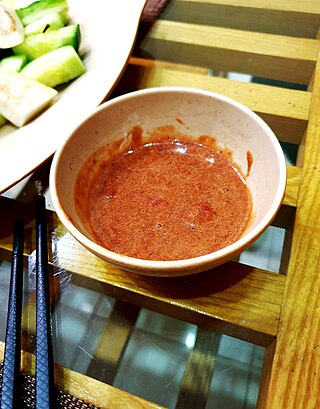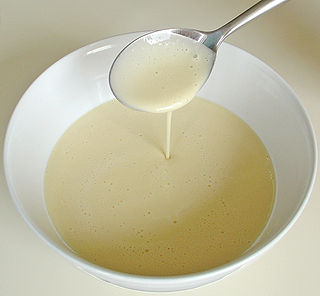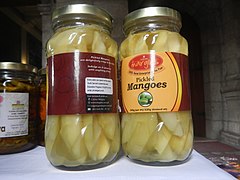
Bagoóng is a Philippine condiment partially or completely made of either fermented fish or krill or shrimp paste with salt. The fermentation process also produces fish sauce known as patís.

Pickling is the process of preserving or extending the shelf life of food by either anaerobic fermentation in brine or immersion in vinegar. The pickling procedure typically affects the food's texture and flavor. The resulting food is called a pickle, or, if named, the name is prefaced with the word, 'pickled'. Foods that are pickled include vegetables, fruits, mushrooms, meats, fish, dairy and eggs.

Shrimp paste or prawn sauce is a fermented condiment commonly used in Southeast Asian and Coastal Chinese cuisines. It is primarily made from finely crushed shrimp or krill mixed with salt, and then fermented for several weeks. They are either sold in their wet form or are sun-dried and either cut into rectangular blocks or sold in bulk. It is an essential ingredient in many curries, sauces and sambal. Shrimp paste can be found in many meals in Cambodia, Indonesia, Laos, Malaysia, Myanmar, the Philippines, Singapore, Thailand, and Vietnam. It is often an ingredient in dip for fish or vegetables.

The generic term for condiments in the Filipino cuisine is sawsawan. Unlike sauces in other Southeast Asian regions, most sawsawan are not prepared beforehand, but are assembled on the table according to the preferences of the diner.

In food processing, fermentation is the conversion of carbohydrates to alcohol or organic acids using microorganisms—yeasts or bacteria—under anaerobic (oxygen-free) conditions. Fermentation usually implies that the action of microorganisms is desired. The science of fermentation is known as zymology or zymurgy.

Tapai is a traditional fermented preparation of rice or other starchy foods, and is found throughout much of Southeast Asia, especially in Austronesian cultures, and parts of East Asia. It refers to both the alcoholic paste and the alcoholic beverage derived from it. It has a sweet or sour taste and can be eaten as is, as ingredients for traditional recipes, or fermented further to make rice wine. Tapai is traditionally made with white rice or glutinous rice, but can also be made from a variety of carbohydrate sources, including cassava and potatoes. Fermentation is performed by a variety of moulds including Aspergillus oryzae, Rhizopus oryzae, Amylomyces rouxii or Mucor species, and yeasts including Saccharomyces cerevisiae, and Saccharomycopsis fibuliger, Endomycopsis burtonii and others, along with bacteria.

Tocino is bacon in Spanish, typically made from the pork belly and often formed into cubes in Spain. In Caribbean countries, such as Puerto Rico and Cuba, tocino is made from pork fatback and is neither cured nor smoked but simply fried until very crunchy; it is then added to recipes, much like the way lardons are used in French cuisine. In the Philippines, tocino refers to sweetened and cured pork belly.

Suman or budbud is a rice cake originating in the Philippines. It is made from glutinous rice cooked in coconut milk, often wrapped in banana leaves, coconut leaves, or buli or buri palm (Corypha) leaves for steaming. It is usually eaten sprinkled with sugar or laden with latik. A widespread variant of suman uses cassava instead of glutinous rice.

Puto is a Filipino steamed rice cake, traditionally made from slightly fermented rice dough (galapong). It is eaten as is or as an accompaniment to a number of savoury dishes. Puto is also an umbrella term for various kinds of indigenous steamed cakes, including those made without rice. It is a sub-type of kakanin.

A mango pickle is a variety of pickle prepared using mango. It is very popular in South and Southeast Asia. These sour/spicy pickles are also available commercially.

Mắm nêm is a sauce made of fermented fish. Unlike the more familiar nước mắm, mắm nêm is powerfully pungent, similar to shrimp paste. Many of the regions that produce fish sauce, for example Central Vietnam, also produce mắm nêm. It is commonly mixed with sugar, pineapple, and spices to make a prepared sauce called mắm nêm pha sẵn, the key ingredient in neem sauce.

Batter is a flour mixture with liquid and other ingredients such as sugar, salt, and leavening used for cooking. It usually contains more liquid than dough, which is also a mixture of flour and liquid. Batters are usually a pourable consistency that cannot be kneaded. The batter is most often used for pancakes, light cakes, and as a coating for fried foods. It is also used for a variety of batter breads.

Sambal is an Indonesian chili sauce or paste, typically made from a mixture of a variety of chilli peppers with secondary ingredients such as shrimp paste, garlic, ginger, shallot, scallion, palm sugar, and lime juice. Sambal is an Indonesian loanword of Javanese origin. It originated from the culinary traditions of Indonesia and is also an integral part of the cuisines of Singapore, Malaysia, Brunei, and Sri Lanka. It has also spread through overseas Indonesian populations to the Netherlands and Suriname.

Curd, also mosaru or dahi or Thayir or Perugu, is a traditional yogurt or fermented milk product, originating from and popular throughout the Indian subcontinent. It is usually prepared from cow's milk, and sometimes buffalo milk or goat milk. The word curd is used in Indian English to refer to homemade yogurt, while the term yogurt refers to the pasteurized commercial variety known as heat-treated fermented milk.

Burong isda is a Filipino dish consisting of cooked rice and raw filleted fish fermented with salt and angkak for around a week. The dish is common in central Luzon, most notably in the province of Pampanga. Angkak may also be omitted, especially in western central Luzon, resulting in a white-colored version. Burong isda variants are usually named after the fish they were made with; e.g. burong bangus for burong isda made with bangus (milkfish). Shrimp versions of the dish are known as burong hipon or balao-balao. Burong isda is very similar to other fermented fish and rice dishes of Asia, including narezushi of Japanese cuisine and pla ra of Thai cuisine. All of these dishes rely on lactic acid fermentation to preserve the food.

Balao-balao, also known as burong hipon, is a Filipino condiment of cooked rice and whole raw shrimp fermented with salt and angkak. Once stir-fried, it can be eaten as is with rice or used as a dipping sauce for grilled or fried dishes. Depending on the salt content, it is fermented for several days to weeks. The lactobacilli involved in the fermentation process of the rice produces lactic acid which preserves and softens the shrimp.
Kiamoy, is a class of Filipino treats made with dried sour plums, prunes, or apricots preserved in brine and vinegar. They are sold covered in a powdery coating of an anise, li hing, salt, and sugar mixture called "kiamoy powder" or kiam-muy-hoon. They are characteristically bright red, orange, or light brown in color. They originate from Chinese Filipino immigrants and are derived from the li hing mui (旅行梅) treats of Chinese cuisine. The name is derived from Philippine Hokkien Chinese: 鹹梅; Pe̍h-ōe-jī: kiâm-muî; lit. 'salted plum'.

















